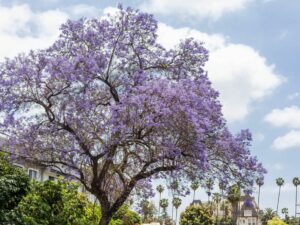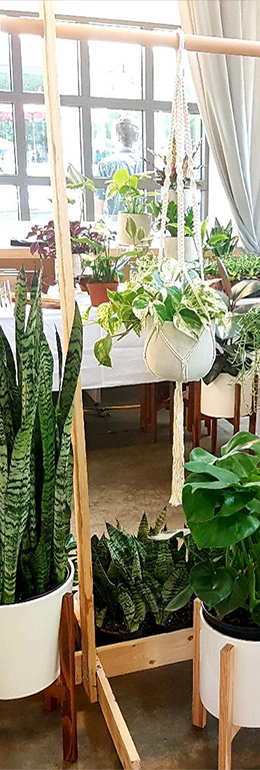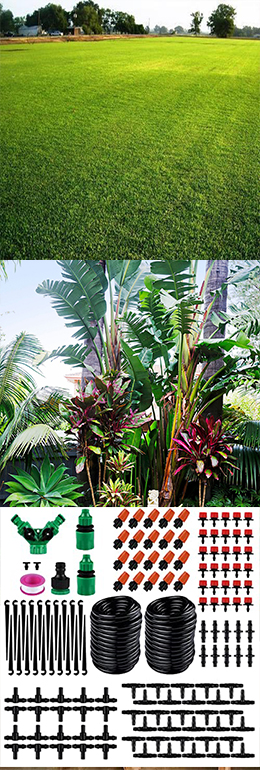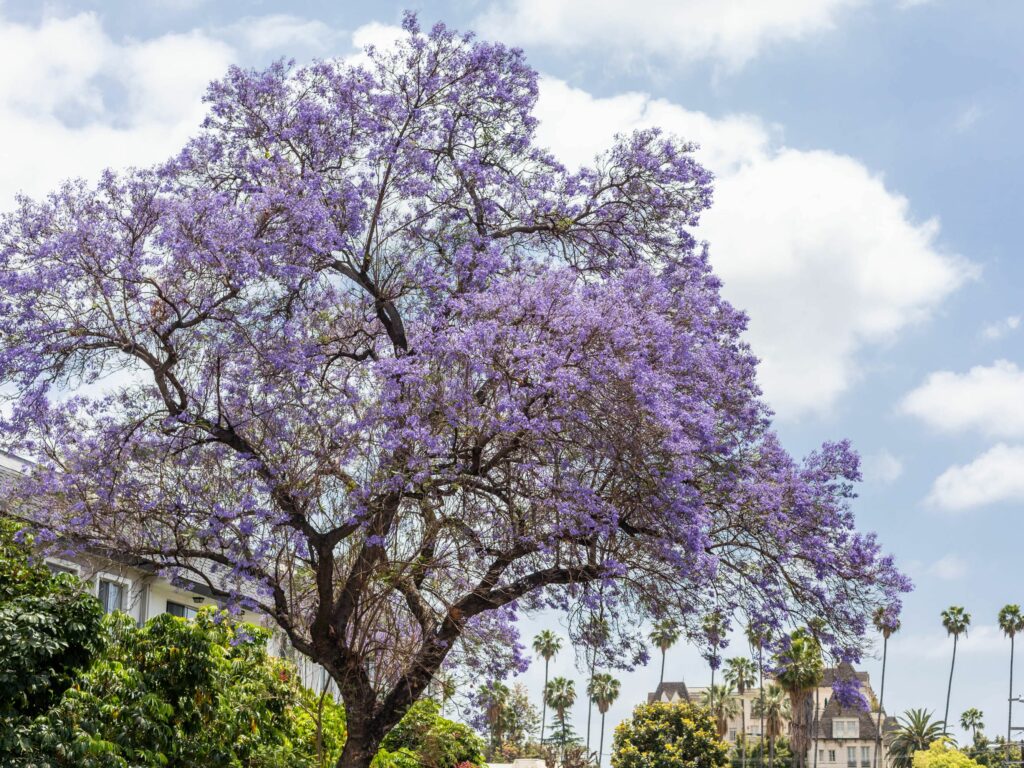Gardening, Outdoor plants, Plants & Flowers, Trees
How to Grow and Care for a Jacaranda Tree
How to Grow and Care for a Jacaranda Tree
The jacaranda tree (Jacaranda mimosifolia) is a beautiful tropical tree that produces clusters of fragrant purple panicle-shaped blooms. Jacaranda branches are arched, forming a canopy shaped like an upturned umbrella. The jacaranda tree makes an excellent shade (or street) tree with its fern-like leaves that can grow up to 20 inches in length. It is a fast-growing tree in a tropical environment, gaining about ten feet a year in its first years of life.1 Its growth rate varies depending on where it’s grown, slowing down to a moderate growth rate outside its ideal tropical environment.
Typically planted between fall and early spring, the jacaranda tree can be considered semi-evergreen or deciduous, depending on where it lives. Only mature jacaranda— eight years or older—will flower, blooming in late spring to early summer (though in warmer areas, the tree can flower at any time). Native to South America, it is an invasive species in several parts of the world.
Types of Jacaranda Tree
There are several notable varieties of jacaranda mimosifolia:
- J. mimosifolia ‘Alba’ or ‘White Christmas’: Full-size tree with a similar habit and care needs; grows up to 40 feet tall and 60 feet wide; lush foliage; its white blooms might arrive earlier than other varieties, starting in April in some climates
- J. mimosifolia ‘Bonsai Blue’: Dwarf cultivar with deep purple blooms; matures at only 10 to 12 feet tall and six to eight feet wide; grows in USDA hardiness zones 9 through 11
- Jacaranda jasminoides: Dwarf cultivar that grows 10 to 25 feet tall produces lilac to dark purple tubular flowers
- Jacaranda jasminoides ‘Maroon’: Dwarf variety that grows 10 to 25 feet tall with dark maroon-purple blooms
Jacaranda Tree Care
In general, jacaranda trees are a good choice for large outdoor areas in warm climates, USDA hardiness zones 10 and 11. They are resistant to pests and diseases and are moderately drought-tolerant (though they require watering during extended dry periods).
The fern-like foliage usually allows diffuse light to pass through, so growing grass under the tree is possible. But, be aware that the tree can have significant surface roots, disturbing sidewalks or nearby structures. Jacaranda leaves, and particularly the flowers, can create a lot of litter when they drop. This messy habit makes the tree a poor choice near pools, driveways, and patios because of cleanup maintenance. If the debris isn’t swept up quickly, it can rot and result in a slimy, slippery mess.
Though jacaranda trees can be grown indoors, they typically will not flower. They must be planted outdoors eventually and are not good for long-term container planting. When grown indoors, jacarandas can attract aphids and whiteflies.
Light
For the best blooming, plant your jacaranda tree in full sun, where it receives at least six to eight hours of sun per day. Smaller jacaranda trees can tolerate light shade if necessary, but a lack of optimal sunlight can impact the amount and vibrancy of their blooms.
Soil
Jacaranda trees will do best in well-draining, moderately sandy soil with a slightly acidic pH level. It’s also tolerant of clay and loamy soils but should not be planted in any mixture that is considered heavy, wet, or not well-draining. Water-logged soil can lead to an increased risk of root rot and mushroom root rot.
Water
As a general rule, water your jacaranda tree when the top three to four inches of soil feels dry to the touch. These trees need consistent moisture throughout the year and often require additional watering during high heat or drought periods. Water the area around the tree’s base. Concentrate most of the water at its drip line (the spot where the water drips off the ends of the branches) instead of near the trunk.
To gauge whether your watering was sufficient, poke a finger or water gauge into the ground up to three inches deep, ensuring the water has seeped down to that depth. Repeat watering this way once a week, increase to several times a week during intense sun or heat periods. Reduce watering to once a month during the tree’s dormant winter months.
Temperature and Humidity
Some jacaranda trees can tolerate occasional cold weather days (as low as 20 degrees Fahrenheit), but generally, this species does not thrive in climates with frequent freezing temperatures. This plant prefers heat and humidity but is vulnerable to trunk scald in areas with constant high temperatures.
Fertilizer
Feed your jacaranda tree annually with a balanced tree fertilizer, but be careful not to give it too much nitrogen, which can affect flowering. A good fertilizer ratio is 10-10-10 NPK (nitrogen-phosphorus-potassium). If you are fertilizing grass under the tree, chances are the tree is already getting a lot of nitrogen.
Pruning
You should prune young jacaranda trees to form one central leader (main trunk) for strength and stability. Avoid pruning beyond that; too much pruning might force it to grow vertical suckers that can distort the tree’s shape. Seasonal pruning should be limited to removing only broken, dead, or diseased branches.
Propagating Jacaranda Trees
It’s best to plant the seeds of this tree between fall and early spring. You can also propagate this plant from a stem or branch cutting (softwood). Grafting is another method, but it’s best done by nursery or horticultural professionals. Propagating via softwood cutting is more advantageous because your plant will bloom much sooner than a plant grown from seed. Also, stem cutting is the more reliable method of propagation because the child plant will be a true copy of the parent. Here’s how to propagate by stem cutting:
Use pruning shears or hand pruners to trim off a 1/2-inch to one-inch diameter branch. You’ll also need either a clear jar of water or a pot of moistened soilless potting mix (with perlite), or a sandy, loamy mix. If you use the water rooting method, you will eventually need a pot of potting soil to plant the rooted stem.
Take a cutting from a branch that has grown past the bark and contains healthy buds. Cut it just above a node (the point where the leaf grows from the stem). Make at least a one-inch diagonal cut; the longer cut surface encourages rooting. The cutting should be at a minimum of three to four inches long and should have at least three nodes on it.
You can put the cutting in a clear glass or jar of room temperature filtered water until roots form (about two weeks), then plant it into potting soil. While you wait for the roots to grow in the water, replenish the water level with filtered, room temperature water. Or, you can directly plant the cut end in an enriched, moist soilless growing medium. Optionally, you can dip the cut end into rooting hormone to boost its chances of root production.
Place the plant in a bright location but not direct sunlight; direct sunlight can burn or dehydrate the cutting.
Once the water-rooted cutting has roots at least one inch long, replant the cutting into a soilless potting mix. After that, do not transplant the cuttings for at least eight months. Allow the plant ample time to establish its root system. Then, find a more permanent home for the plant outdoors or transfer to a larger pot—at least five gallons or more.
How to Grow Jacaranda From Seed
The fruit of the jacaranda tree is a dry round brown pod that is one to three inches wide and typically develops in late summer. To harvest the seeds for replanting, pick the seed pods directly from the tree when they are dry (pods that have fallen to the ground might not contain seeds).
Soak the seeds in water for 24 hours.
Place the seeds on a bed of potting soil in seedling containers or pots. Cover them with a thin layer of potting soil and keep the soil moist. The seeds should sprout in two to eight weeks.
Wait eight months before you transplant the seedlings.
Potting and Repotting Jacaranda Trees
Container-grown jacaranda trees will need to be planted in containers at least five-gallons in size, using a sandy loam potting mix that drains quickly. The soil should be kept moist but not soggy throughout the active growing season.
If you are transplanting jacaranda, do it in the winter after they drop their leaves but before they bud out in early spring.

Transplanting them while they are dormant reduces stress and increases the likelihood of success.
In the tropics, these trees grow 50 feet tall, outgrowing containers. But in cooler climates, they can be grown as container trees growing to about eight to ten feet if you annually prune and shape the tree during dormancy to keep it on the smaller side.
Overwintering
As tropical trees, these plants will likely not survive climates that freeze for extended periods. It can handle a cold snap here and there, but beyond that, you’re asking for tree death. If your winter temperatures sometimes dip, the tree can tolerate occasional 20 degrees Fahrenheit days with a cold snap here or there. To mitigate any potential winter frosty days, think ahead and plant the jacaranda in a sunny area that has some protection from gusty winds.
When jacaranda trees in pots are taken indoors for the winter, they should be watered less frequently and allowed to dry out a bit. A dry period in the winter triggers more blooms in the spring. Similarly, a soggy, wet winter usually means the tree will produce fewer blooms in spring. Prune the potted plant during the dormant winter period; this keeps your potted jacaranda tree from growing too large. Each year, it becomes more difficult to bring the plant indoors for the winter if you don’t prune it.
Common Plant and Pest Diseases
The jacaranda tree is susceptible to aphids and scale insects, and the glassy-winged sharpshooter can also infest its leaves. You can manage all of these pests with insecticidal soap or horticultural oil.
Disease rarely affects jacaranda trees; however, insects like the sharpshooter carrying the bacteria Xylella fastidiosa can cause trees to develop bacterial leaf scorch. The bacteria block the tree from getting the water it needs. To prolong the tree’s life, water it frequently. However, there is no cure for the disease, so ultimately, the tree will not likely survive.
Trees that do not have properly draining soil can develop mushroom root rot. This disease is caused by a pervasive fungus and has no real cure other than removing the dying plant. To confirm this disease, it appears like an area of the bark has blackened and died. Upon peeling back the dead bark, you’ll notice a white fungal growth.
How to Get Jacaranda Tree to Bloom
Jacaranda trees bloom twice a year, once in spring in late May or early June, and again in the fall. The trumpet-like blooms have a freshly fragrant smell, although their decomposition is pungent and foul-smelling when the flowers wither and fall. This tree is on the messier side; sweep and rake the spent blooms as soon as you can to avoid a smelly situation.
For the best result with getting a jacaranda to bloom, plant it in a sunny area with well-draining soil (preferably sandy). Make sure the ground around a jacaranda tree remains moist but not soggy. Protect the tree from harsh winds. Stop fertilizing grass growing nearby a jacaranda. Fertilizer, particularly nitrogen, inhibits flower production.
Common Problems With Jacaranda Trees
In the U.S., these trees are happiest in the balmiest locations—Hawaii, the South, Southern California, and parts of Texas. They grow remarkably easier there, where the conditions are ideal. Problems crop up most when its water, sunlight, and temperature needs are not being met.
Yellowing Leaves
If your tree is not watered deeply enough, it might not produce enough chlorophyll, causing chlorosis, which causes green leaves to turn yellow. Provide your tree with ample water. Water on a schedule and give your plant a deep watering on overly hot days.
Browning, Dying Leaves
Trees that have developed the insect-borne bacterial leaf scorch disease look like they are deprived of water. Leaves begin wilting, browning, and dropping. The branches and stems dry out and become brittle. There is no cure for this disease. Other potential causes for browning leaves are leaf scorch from too much sun or an overabundance of fertilizer. Check those factors. If the sun is overwhelming for the plant, it might be worth it for you to transplant the tree to a more suitable location.
Dead Leaf Tips
Excessive fertilizing can damage the mineral to salt ratio in the soil, causing dead leaf tips and yellowing leaf edges. If the leaf tips appear to die after fertilizing, it might be the cause of your tree’s leaf issues. To correct an overfertilized tree, remove the dying or wilting leaves and water the fertilized soil thoroughly, trying to flush out the fertilizer.
FAQ
How long can jacaranda trees live?
The average lifespan of a jacaranda tree is 50 years old, and in a happy environment, it can live up to 200 years.Can jacaranda trees grow indoors?
Early in its life—for the first few years—it can grow indoors if it has a bright sunny spot. However, it is such a tall, blooming tree that it will eventually need to be planted outdoors to reach maturity.What are alternatives to a jacaranda tree?
If you live in a colder climate and love the jacaranda tree, you might be disappointed when your tree becomes too big to bring inside for the winter. A vitex tree is a suitable alternative that can tolerate colder temps and produces flowers with pretty blue spikes around the same time as a jacaranda tree. It also grows half as large—only about 25 feet versus the 50 feet of a jacaranda tree.

 العربية
العربية


